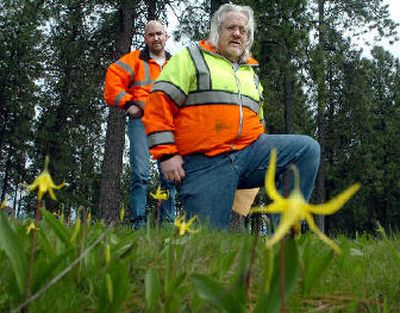Wildflowers with domestic roots

At 70 mph, they can look like yellow flecks of litter.
A closer look in the roadsides and median along Interstate 90 between Post Falls and Coeur d’Alene reveals something of a moving garden tour. Beginning about now, this stretch of highway offers prime viewing of native wildflowers.
The yellow splotches are the blossoms of glacier lilies and yellowbells. Mixed in are lavender splotches of grass widows. Their emergence is just the start of a show that lasts much of the summer, said Judd Reed, regional roadside vegetation manager for the Idaho Transportation Department.
Peak color usually doesn’t start for a couple of weeks, when the sunflower-like arrowleaf balsamroot plants pop up.
This stretch of I-90 is especially good for wildflower viewing because it offers an unusually wide median and rights-of-way, Reed said. The highway was constructed in the early 1970s, during a national emphasis on reducing roadside clutter and boosting natural beauty. Much of the push was sparked by Lady Bird Johnson, the former first lady.
Native wildflowers and grasses are planted along highway shoulders statewide, Reed said. They not only add scenery, but their roots anchor soils. Mixes can be tailored to ensure tall plants don’t block motorists’ vision. Care is taken to select species that don’t attract deer.
Although the flowers are native, they need a helping hand to survive the tough interstate environment, Reed said. There is trash of all kinds, but an even bigger threat to their survival are invasive weeds, including Dalmatian toadflax and spotted knapweed.
To destroy the weeds without killing the flowers, Reed and his crews hand-spray chemical weed killers, especially in flower-packed areas. This offers a more targeted assault than broadcast spraying, but it’s also much more time-consuming. Special insects have also been released by the state agency to combat weeds, but the bugs haven’t seemed very effective, Reed said.
Reed said he’s not sure if motorists like the display. Usually, his only feedback is when people complain about too much or too little roadside vegetation. “My job, if I do a good job, people don’t notice it at all. It looks natural,” he said.
But Reed takes special pleasure in helping the wildflowers thrive.
“Most of our job is spent killing weeds. It’s nice to go out and make it look good,” he said on a recent morning, while walking through a wildflower patch near the Huetter rest area. As he walked, he was careful to avoid stepping on the yellow lilies popping through the bed of pine needles.
Native wildflowers have been planted along hundreds of miles of state highway in North Idaho. Reed’s district includes 1,300 miles of roadside shoulder. Reed had difficulty naming a favorite stretch. One of the more colorful drives, he said, might be the White Pine Scenic byway, which runs roughly from Cataldo to Potlatch.
Since 1995, the Idaho Transportation Department has supplied native wildflower seeds to volunteer groups that adopt and clean highway segments. The groups are given instructions on planting and care, said Sherie Sweaney, volunteer coordinator for the agency. Nearly 60 groups have volunteered to care for segments of state highways in Idaho’s five most northern counties.
The state’s first priority is motorist safety, but beautification is also important, Sweaney said. “People appreciate it, but they don’t say too much.”